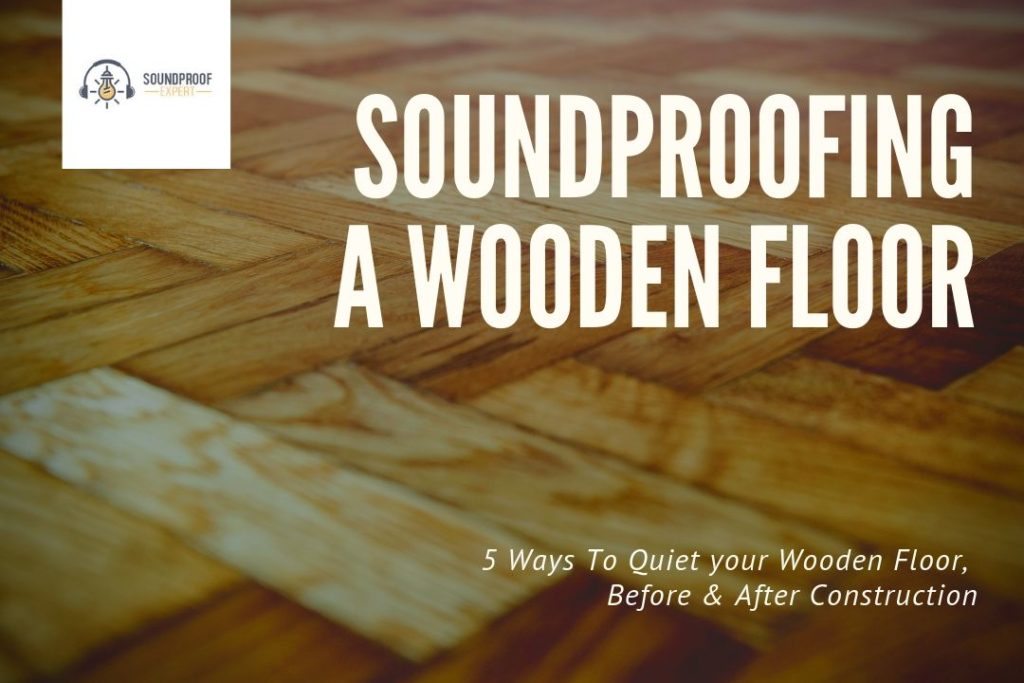
Whether you live in an apartment, loft, 2 story home, or even a single level home, if you have wooden floors, you know how loud they can typically be.
While real hardwood tends to absorb more sound than cheaper laminate wood flooring, they both are much louder than carpet and can be a nuisance for neighbors.
Today I am going to look at the different types of noises that affect wood floors and some ways that you can soundproof your wooden floor.
These tips will help you ensure that your noise levels are decreased dramatically and hopefully your neighbors will be much happier. Let’s start by taking a look at the different types of noises so we can better address the ways to tackle each type.
Install An Underlayment Under The Wood
Starting off my list is something that needs to be done prior to the installation of your wood floor.
Unless your wood floor is easy to uninstall and reinstall, this step is for those who are planning ahead in a renovation or new construction.
When installing wood floor, it is always recommended to install an underlayment (click to see my recommended product on Amazon) under the wood to help cushion the flooring. This cushioned underlayment allows for your wood floor to rest on a soft surface as opposed to the floor’s plywood or concrete surface.
Underlayment comes in many different materials with the most common being cork or foam. This soft material installs on the bare floor before you lay your wood down. Due to its construction, this underlayment allows for both impact and airborne noise to be suppressed.
While this does add to your overall cost of renovation or construction, it is best to do it now and not regret not having done it in the beginning. After all, it’s better to have it and not need it rather than need it and not have it.
Use Green Glue When Attaching Wood To Floor
If you are able to remove and reinstall your flooring with ease, or you are about to install new wood flooring, you have the choice of using Green Glue Noiseproofing compound as a sound proofing technique.
Green Glue is a damping noiseproofing compound that is applied between your subfloor and your new wood floor to help dampen sound that would normally travel through your floor.
Green Glue is available in tubes or buckets and can be applied by just about anyone with minimal knowledge on applying compounds.
One of the best features of Green Glue is that you do not have to apply it in any particular pattern. You can simply apply it as you please as long as you get adequate coverage.
Green Glue can also be used to help soundproof walls as well. This can help to add to your overall soundproofing of your home or rooms. One of the downfalls of using Green Glue is that it takes about a week for you to start to see improvements in soundproofing.
This is due to the glue needing to completely dry and become elastic for the full damping effect.
Use Carpets Or Rugs In Sections Of The Floor
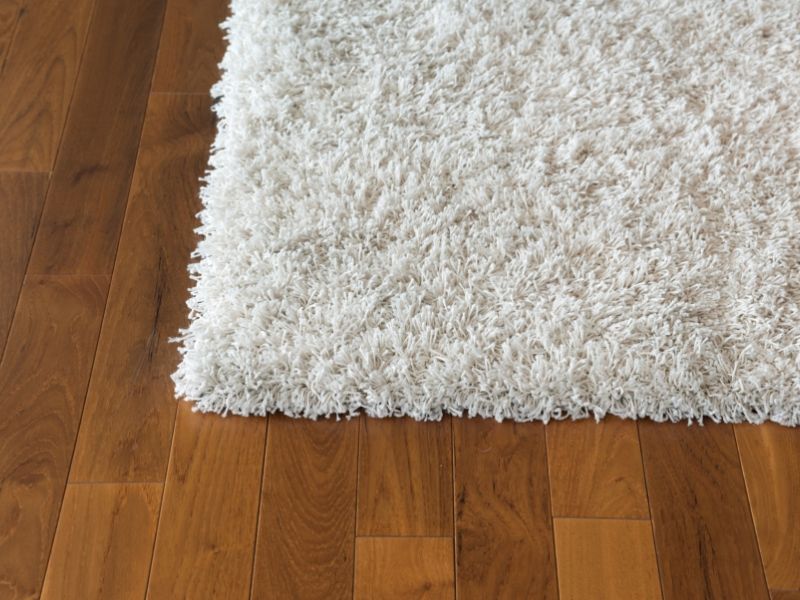
The reason you will notice more noise in a room with wood flooring as opposed to carpet is because carpet naturally absorbs noise.
It’s like a built in soundproof flooring solution. Just because you have hardwood floors doesn’t mean you can’t use carpet to help soundproof your floor.
If you are wanting to get your wood floor more soundproof, you can add carpeted rug pads throughout your house. Rugs are meant to provide a cushioned area of carpet that allows you to not only decorate your home, but get some soundproofing as well.
The best thing about carpets is that they are not permanent and you can move them where you need them.
For example, if you are trying to prevent impact noise from a place where items are dropped or places that you commonly walk, rugs can help reduce the noise.
Setting rugs under speakers, TVs, or radios allows the sounds to travel through the rug, softening the tones that were normally traveling through your wood floor.
Rugs come in all shapes and sizes that make them easy to mix and match to any type of layout. Because they are cheap and portable, they are the best choice for those who are renting an apartment or home.
Use Rubber Mats
When it comes to impact noises on wooden floors, nothing works quite as well as rubber mats. Rubber mats act as a buffer for your floor and can absorb both the blow of the impact and the noise.
These mats are great for rooms that will be used for working out, kids play areas, and pet areas as they are resilient under harsh use and absorb sound really well.
While most think of heavy black mats when they hear about rubber mats, you can actually get these in various shapes, sizes, and colors to fit your specific needs. This is great for keeping certain themes in each room as you would not want the same type of rubber mat designed for a kids room in your weight room. Let’s look at a few examples you can choose from.
Kids Room – Rubber mats for kids room serve multiple purposes. They are easy to clean, reduce overall noise, and provide a soft cushion for when your kids fall.
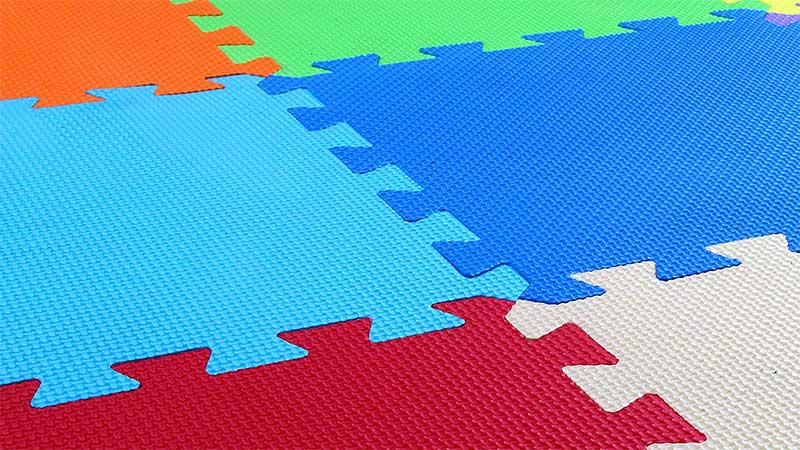
These add a playful touch to the floor while providing great sound deadening and fall protection.
Workout Room – Workout rooms are all about picking up and setting down weights or running on treadmills. This can cause a lot of noise, not to mention the wear and tear on your beautiful wooden floor.
Heavy duty rubber mats are a great way to solve all of these problems and give your workout room a gym-style look
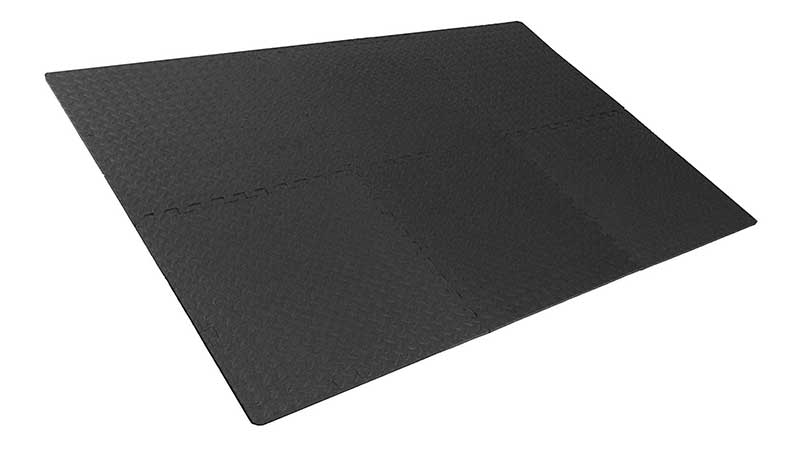
How Much Does It Cost?
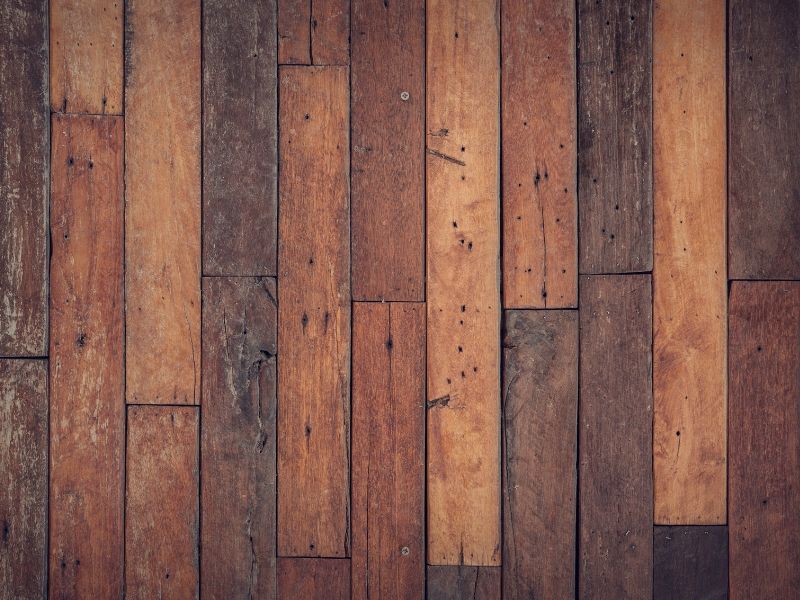
When it comes to soundproofing your floor, you are going to want to know what it is going to cost. The simple answer is that there is no cut and dry cost for soundproofing a floor.
With many different ways you can soundproof a floor and the varying square footage of living spaces, your cost is going to greatly depend on which type of soundproofing you decide to go with.
An easy way to figure out a ballpark amount for soundproofing your wooden floor is to figure out what type of soundproofing you are going with, getting the price per square foot, and calculate that with the amount of space you are looking to cover. There are many square foot calculators available online to help you figure this out.
The overall cost can vary depending on how much you want to soundproof too. If you are just wanting a few simple rugs for impact noise, you can get out for about $100 depending on your rug choice.
If you need to block a serious amount of sound, you can expect to get into the $500-$2000 range, of course this depends on the size of the living space.
To save the most money and reduce future spend, look at soundproofing floors before they are installed if at all possible.
What Are The Different Types Of Noises?
Noises are all around us and many people do not understand that there are various categories of noises. When it comes to flooring noise, there are two categories that noises fall under – impact and airborne. To understand the type of soundproofing you will need, you will need to understand what type of noise you will be dealing with the most.
Impact
Impact noises are the noises that are going to come from falling objects, feet stomping, and any other noise made by an object coming into contact with your floor. With the composition of wood flooring, contact with this type of surface usually makes a louder noise as wood flooring is hard and flat.
Impact noises not only affect downstairs neighbors, they can affect you as well. Dropping items onto wooden floors, especially if they are laminate flooring, can cause some serious noise. Enough so to wake babies, sleeping kids, and startle your animals. Impact noises are usually the easiest noises to help soundproof.
People who will see more impact style noises are those with weight rooms, parents who have kids who like to throw things around, and people who have pets who run around the wooded floor. If you have any of these and live above neighbors, it will be very considerate of you to take some time to access your soundproofing and see how you can keep the noise level to a minimum.
Airborne
Airborne noises are noises caused by sounds that travel across your room. This can include voices, music (especially with heavier bass), TVs, pets, and other audible sounds. Since wood flooring is not as soundproof as carpet, your airbourne sounds tend to travel much further, bleeding into neighbor’s apartments or echoing in the room that you are in.
As you start to add more furniture and paintings into your room, these items will naturally start to soundproof the room as they will capture some of the sound being emitted.
While this will help, it will not totally soundproof the floor, leaving your downstairs neighbors with no choice but to listen to your music or TV.
Airbourne noises are harder to control as different sounds travel at different rates. While you may think you are good since your TV normally isn’t a bother to your neighbors, when you start watching a movie with louder scenes, your soundproof may not be sufficient for these louder noises.
Conclusion
So now that you know how to soundproof your wooden floor, it’s time for you to get to work!
Each of these steps has been tested and proven to help reduce the noise levels in rooms with wooden floors and will be a great way to help not only you, but your neighbors when it comes to unwanted noises.
If you have done some soundproofing on your wooden floor, I want to hear from you!
What method did you use to reduce sound going through your wooden floor? How much sound has vanished now that you have used that method? What did you pay for your sound deadening solution?
